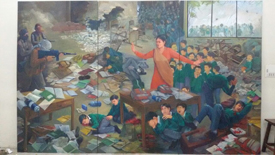CAA News Today
‘Massacre of the Innocents’
posted by CAA — Sep 09, 2015
Musarrat Hasan is an advisor to the Institute of Art and Design and professor of art history at Lahore College Women’s University in Lahore, Pakistan. She was a 2013 participant in the CAA-Getty International Program.
In Pakistan, the Taliban and many other militant groups have carried out terrorist activities for the last several years, killing thousands of people through suicide bombings and other horrific attacks. Their aggression has now been greatly curtailed through the joint efforts of the military and the citizens of Pakistan. However, on December 16, 2014, seven gunmen affiliated with the Taliban conducted a terrorist attack on the Army Public School in the northwestern Pakistani city of Peshawar. They entered the school and fired on school staff, teachers, and children, killing 145 people, including 132 schoolchildren between eight and eighteen years of age.
Worldwide protest and expressions of horror at this outrage followed immediately. The artists of Pakistan, like their fellow citizens, were greatly shaken by the brutal event. Through their national organization, the Artists’ Association, they decided to make their outrage public. During a meeting of the organization’s executive committee, under the leadership of Mian Ijaz ul Hassan, the group condemned the Peshawar attack and voted to devote the upcoming annual exhibition to artistic responses to this violence. The organization sent out a notice to members and all other artists in universities, cultural bodies, and international members, announcing that the annual show would be postponed by about three weeks so that all members and other artists could participate. The title for the exhibition would be ‘Massacre of the Innocents’ and it would be about the suffering of innocents all over the world.
Although Pakistani artists have previously responded to national and international events of tragic and human significance, I do not recall a collective public response to current events by artists carried out with such immediacy. There have been instances of commissioned murals years after the event, but this sort of action was unprecedented.
 At the Lahore College Women’s University, the faculty members were also motivated to participate and decided to collectively produce the mural that is illustrated here. They pooled funds to buy oil paints, panels of stretched canvas, and other materials required for the mural. I was honored to supervise the creation of this work from conception to completion. We decided not to dwell on the gruesome murders but instead to celebrate the bravery and sacrifice of the headmistress who faced the Taliban with courage and gained time for hundreds of students to escape, even though she herself was killed in the process.
At the Lahore College Women’s University, the faculty members were also motivated to participate and decided to collectively produce the mural that is illustrated here. They pooled funds to buy oil paints, panels of stretched canvas, and other materials required for the mural. I was honored to supervise the creation of this work from conception to completion. We decided not to dwell on the gruesome murders but instead to celebrate the bravery and sacrifice of the headmistress who faced the Taliban with courage and gained time for hundreds of students to escape, even though she herself was killed in the process.
The final mural is 8 x 13 feet and demonstrates the painting skills and commitment of fourteen young faculty members who worked on weekdays and late into the night, putting their hearts and souls into the timely completion. The faculty members of the Lahore College Women’s University who worked on this project were Rifaat Dar, Aasma Majeed, Amber Muneer, Aqsa Rehan, Sadia Murtaza, Samina Naseem, Farah Khan, Ghazala Anjum Shirazi, Nighat Mahboob, Rehana Salman, Rabia Yaseen, and Maryam Baber.
The exhibition at Lahore was a great success. It stirred the community and also inspired many other artists to participate in a subsequent exhibition held at the National Art Gallery in Islamabad. The Shakir Ali Museum in Lahore collaborated with the Artists’ Association in this endeavor. The exhibition is scheduled to travel to other major cities such as Peshawar and Karachi later this year.


